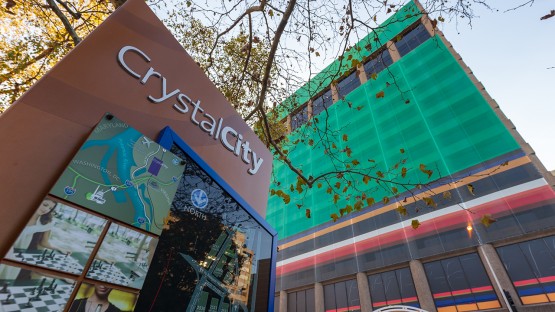A team of Cornell students found an artful way to snare the sun’s energy, store it and then optimize it for the built environment as part of the U.S. Department of Energy’s inaugural Solar District Cup collegiate design competition.
Cornell placed third in the urban district category of the contest, held over the course of a year, concluding April 26-27. Dartmouth placed first and Colorado School of Mines was second.
The contest teams designed solar plans for Crystal Parks, a section of the Crystal City neighborhood in Arlington, Virginia, adjacent to Washington, D.C.
“Our team proposal was specifically constructed and organized around the needs and interests of the Crystal City master plan,” said team leader Michael Callender, MBA ’21, noting that online retailer Amazon’s second headquarters will be built there.
“Solar is not treated as merely a mode for generating electricity and reducing costs,” he said, “but also an opportunity to use the technology as artwork and to create a sense of place.”
The contest, funded by the National Renewable Energy Laboratory and the Office of Energy Efficiency and Renewable Energy – all part of the DOE – encouraged student teams to design, model and plan reliable, resilient and cost-effective solar energy systems. The contest also offered students an opportunity to examine solar energy storage, energy finance, microgrids and project planning.
The Crystal Parks neighborhood is a stone’s throw from Ronald Reagan Washington National Airport. The area is rife with office space, apartments and restaurants, all served by the blue and yellow Metro subway lines.
Cornell’s design plan featured 4,107 solar panels installed through a five-building rooftop system, and on garage roofs, decorative flower-shaped solar panels and solar energy-powered kiosks to gather about 1.5 million watts annually. The system was designed to store enough electricity for more than an hour of emergency use.
The team stressed that their design should be part of the aesthetic of the neighborhood.
“The technology should not be hidden behind buildings and on top of roofs, but instead it should be in the public eye, enriching the lives of those who see it,” said Hannah Contreras ’21, one of the team’s designers. “Solar energy is diverse. It can power buildings, function as artwork and power the subway station screens that tell riders when the next Metro train arrives.”
The contest started about a year ago with 61 teams from more than 50 colleges competing. Last fall, the DOE whittled the field down to 35 teams; in late April, each group developed a 15-minute presentation for judging.
“With my interest in renewable energy, I sought to gain firsthand knowledge of the entire process of a solar project,” said Samay Shah, M.Eng. ’21. “I wanted to better understand the key-decision variables that go into deciding the different features of a solar project and this project did exactly that.”
In addition to Callender, Contreras and Shah, team members were James Bonzani ’23, Nick Ionnarone ’22, Grant Logan ’23, Sai Mallipedhi ’21, Shivanie Rambaran ’20, Olivier Tameze-Rivas MBA ’20, Pam Wildenstein ’20 and Annie Yu ’20.
Matt Ulinski, director of the Master of Engineering Program in the Sibley School of Mechanical and Aerospace Engineering, serves as the team’s adviser.















